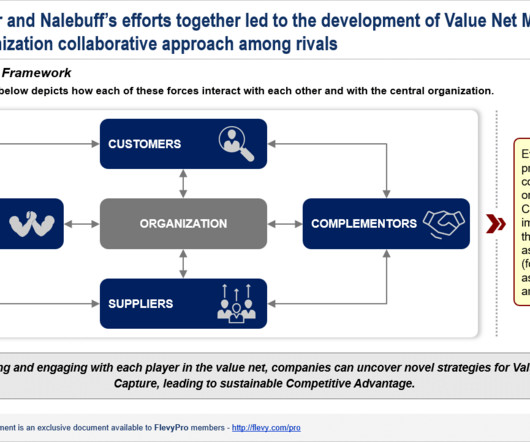Value Net Model
Flevy
MAY 7, 2024
The model identifies 4 key types of players: Customers Suppliers Competitors Complementors Each player type holds strategic implications for organizations, influencing their operational and strategic decisions.

Flevy
MAY 7, 2024
The model identifies 4 key types of players: Customers Suppliers Competitors Complementors Each player type holds strategic implications for organizations, influencing their operational and strategic decisions.

Customer Think
DECEMBER 4, 2022
Unilever was preferred for edible oil in retail because they phased out non-sustainable production of palm oil, and their procurement of such oils from sustainable conscious suppliers increased the cost. Customers were willing to pay for this and selected Unilever for their effort. The above are just a few examples of value centers.
This site is protected by reCAPTCHA and the Google Privacy Policy and Terms of Service apply.

QYMATIX
MARCH 19, 2024
The Trust-Loyalty Nexus in Dynamic Pricing Customer trust and loyalty are the lifeblood of B2B sales , but implementing dynamic pricing can be perceived as a double-edged sword in this context. Customers value transparency and consistency. Dynamic pricing, when managed effectively, can achieve both.

QYMATIX
MARCH 19, 2024
The Trust-Loyalty Nexus in Dynamic Pricing Customer trust and loyalty are the lifeblood of B2B sales , but implementing dynamic pricing can be perceived as a double-edged sword in this context. Customers value transparency and consistency. Dynamic pricing, when managed effectively, can achieve both.

Luminas Strategy
DECEMBER 12, 2022
Keith Pigues At the center of pricing and revenue management (two very important topics for every business, large or small) is the matter of Customer Value Management. The first component of customer value management is customer value creation – the amount of value a supplier’s offering creates-for or provides-to a customer.

Mercuri International
MARCH 8, 2022
Value-based selling has been around for more than 30 years and is still as relevant as ever. When Mercuri Research recently surveyed the most important challenges for business leaders, customer value orientation came out on top, just as it did in our last survey 5 years ago.

OnStrategyHQ
MAY 1, 2023
What do our customers value most from our organization? What do our customers value most from our organization? How do we uniquely serve our customers? Industry Data and Trends This data looks at what’s happening in your industry, including factors like vendors, suppliers, competitors, and buyers’ power.
Let's personalize your content